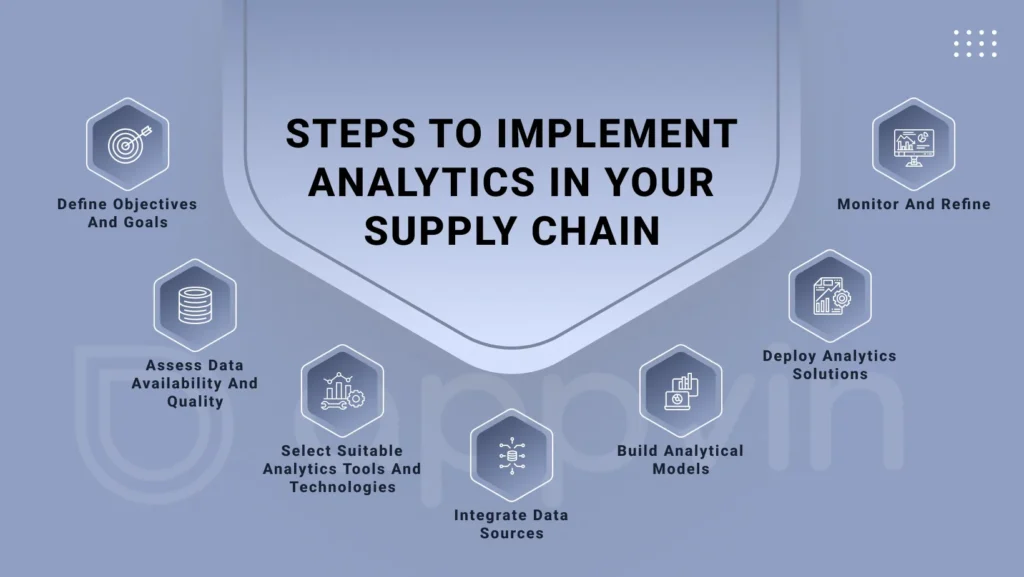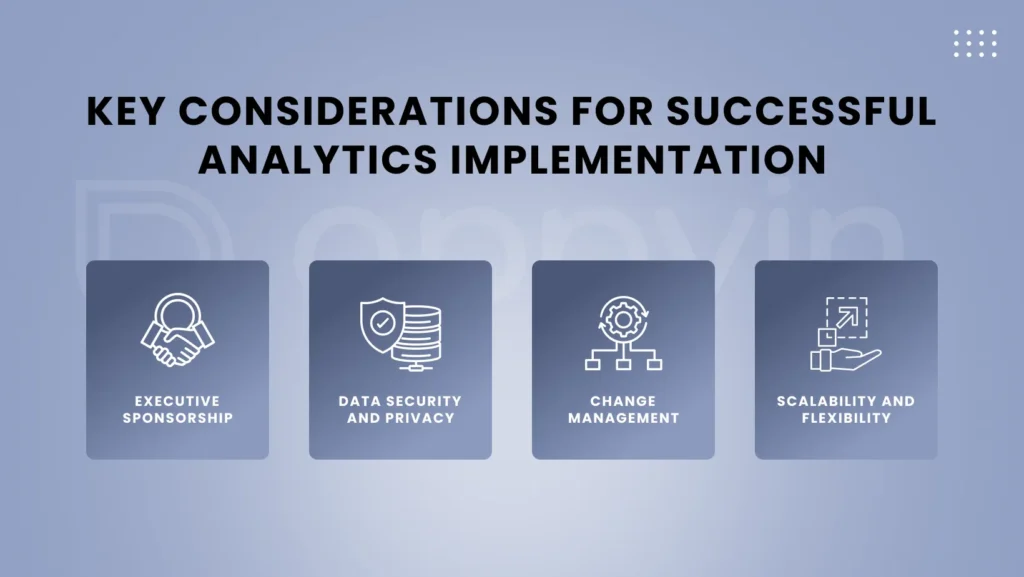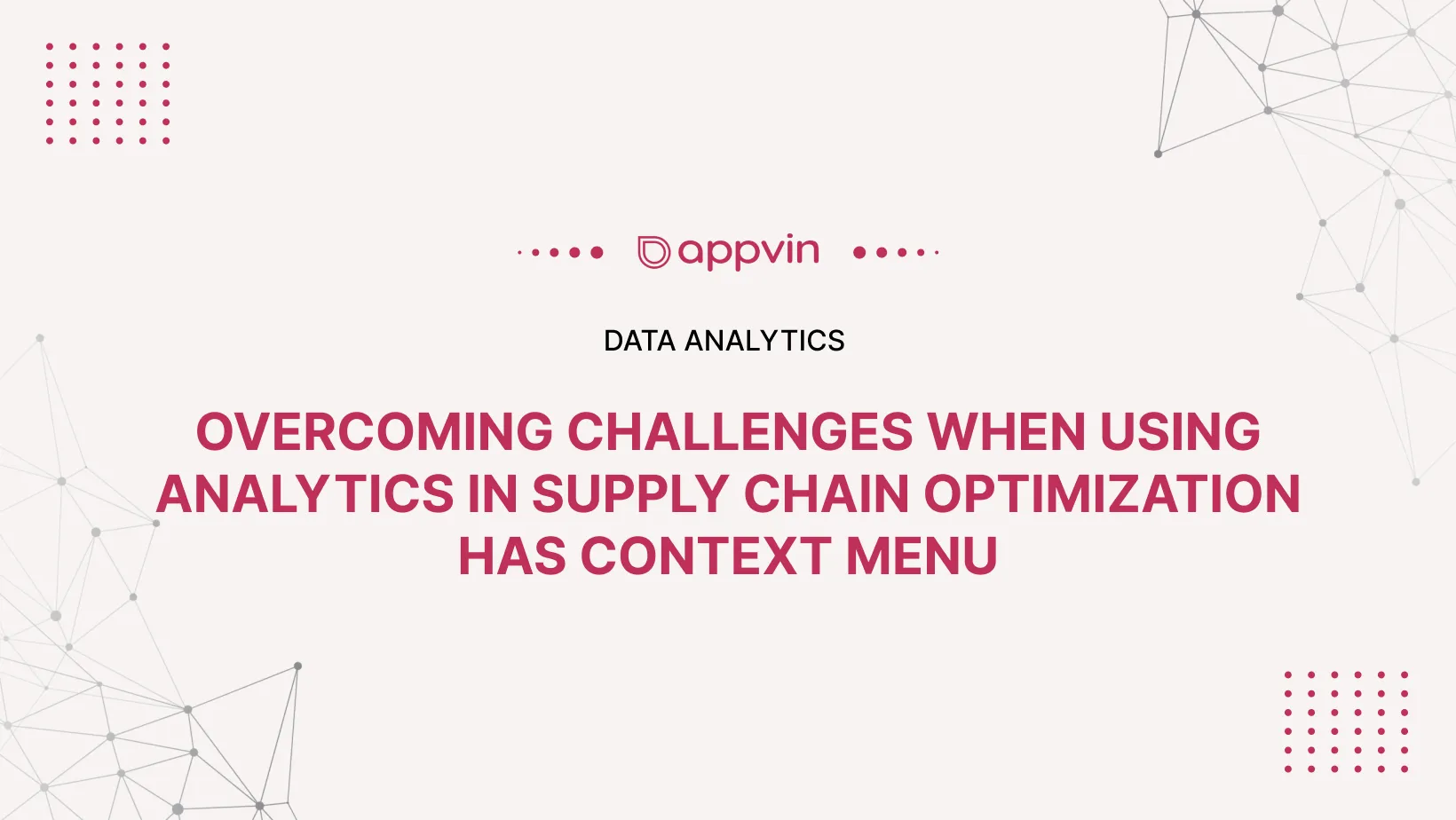Supply chain analytics is the power tool that can revolutionize your operations. The first step is to identify the KPIs to track inventory levels, lead times, and customer satisfaction rates. Consequently, the second step is collecting data from varied sources like ERP, WMS, and TMS systems and integrating it into a single common repository.
Use descriptive analytics to understand historical performance and trends. Enable predictive analytics using forecasting models and machine learning algorithms to be able to predict future demand and possible disruptions. Therefore, using prescriptive analytics with optimization models and decision support systems. To understand the recommendation of the best possible action.
Introduce supply chain visibility tools that will allow one to track goods, materials, and assets at any given point through the whole supply chain. It will also be easy to optimize the level of inventory since bottlenecks can easily be identified. Finally, there needs to be seamless collaboration and information sharing among all partners: suppliers, producers, logistic companies, and consumers. This article explores how to implement analytics in your supply chain and the key considerations for successful ones.
Steps to Implement Analytics in Your Supply Chain
Implementation involves defining clear objectives for supply chain analytics, assessing the quality of data, selecting tools, integrating the data, building analytical models, deploying solutions across operations, and monitoring and refinement. It involves fostering a data-driven culture and optimizing the performance of the supply chain.
Here are some key steps to implement successful analytics in your supply chain:
Define Objectives and Goals:
Define the objectives and goals of using supply chain analytics. It could be to improve operational efficiency and reduce costs, provide better customer service or improve inventory levels and risk mitigation. Next, establish how to leverage the data towards solving these issues. Prioritize the supply chain issues that need to be attended to with urgency. Moreover, among those, choose one as a pilot to what will be your long-term goal for the supply chain. Remember, the success of this will radiate across the organization.
Assess Data Availability and Quality:
Data sources in your supply chain can include ERP, WMS, TMS, and CRM systems. Ensure the availability, quality, and accuracy of the data needed for your analytics projects.
Data List:
Create a list of data types in your supply chain— both internal (e.g., sales, inventory, logistics) and external data (e.g., market trends and supplier data).
Data Quality Assessment:
Identify data quality gaps in accuracy, completeness, consistency and timeliness, and identify areas for improvement.
Select Suitable Analytics Tools and Technologies:
The choice of analytics tools and technologies that would be used in the supply chain analytics implementation is a critical success factor. Begin your work by researching and comparing options on how to select the ones best positioned to meet your objectives, budget, and IT infrastructure capacity. For that reason, the choice of tools must do data visualization, predictive analytics, and machine learning.
Besides, you need to ensure that you have the right technology components in your technology stack. For example, data warehouses and ETL (extract, transform, load) tools. This should help to build a solid base for efforts in analytics so that you can process and analyze supply chain data.
Integrate Data Sources:
In this step, you should integrate various data sources so that an integrated view of the supply chain can be achieved. However, design an approach that would centralize data flowing from internal systems and external partners into one repository. Data needs to be unified from varied sources either in a data repository or in a data lake. Ensure there are processes for cleaning, transforming, and standardizing the data to maintain consistent data quality.
Build Analytical Models:
Respond to your supply chain goals using statistical methods, machine learning algorithms, and other analytical techniques. Begin with a problem statement that defines your need to resolve it or what opportunities you are looking to exploit.
Furthermore, develop models that serve your goals; validate models using historical data to ensure they generate accurate and reliable results. Construct analytic models using techniques like descriptive analytics, predictive analytics, and prescriptive analytics. The models should align with the objectives and goals that you have defined.
Deploy Analytics Solutions:
The implementation and operation of analytics solutions in supply chains could involve integrating the developed solutions in existing systems, training personnel, and setting in motion the processes for data-driven decision-making. However, this is where your analytical models are integrated into production and are made usable. This process requires careful planning to ensure the models work in a team with the existing systems and processes.
Monitor and Refine:
Continuous monitoring is based on the belief that even small improvements can lead to huge gains over the years and fosters a subculture of learning, innovation and record-based decision-making at all levels so through employee engagement and focus on customer value. Additionally, through feedback and data analytics, the organization continuously captures efficiency opportunities to provide continuous improvement in productivity, quality and overall performance.
Enable Data-Driven Decision-Making:
Make data-driven decisions work by making insights from your analytics tools usable for your decision-makers at all levels of your organization. Create intuitive dashboards and detailed reports that bring data to life, clearly and concisely, and are tailored to specific needs. Such tools should enable important key metrics, trends, and even predictive insights for use during strategic or operational decisions to be brought to light.
Evaluate and Optimize:
Continual monitoring and optimization of the analytics implementation toward long-term success and adaptability. Therefore, continuously track how well your analytical models and tools are performing relative to the original goals and objectives to ensure that they are being met. However, utilize KPIs and other metrics to gain access to their effectiveness. Gather feedback from users and stakeholders to identify areas that might need improvement.
Key Considerations for Successful Analytics Implementation
Analytics effectively applied throughout the supply chain focus on addressing such key considerations to ensure a seamless and successful process. These considerations are a long way to help in developing a strong framework. This supports sustainable analytics initiatives to maximize the value derived from data.
Here are some key considerations for successful analytics implementation in your supply chain:
Executive Sponsorship:
Gain buy-in and active support from the highest levels within the organization for the effective adoption and integration of analytics. Moreover, executive sponsorship helps prioritize resources, drive cultural changes, and align analytic initiatives with strategic business objectives.
Data Security and Privacy:
There should be strong data security to protect sensitive information. In a way that will be compliant with the data privacy regulations that could apply. Establish policies and protocols for data access, use, and governance to ensure data integrity and confidentiality.
Change Management:
Make the change in the organization effective through well-designed training programs, delivering the benefits of analytics, and removing resistance to new technologies and ways of working. Instil a data culture and continuous learning to ensure full absorption and embedding of technology into ways of working.
Scalability and Flexibility:
Ensure that the analytics solution can scale toward the future and to business needs that will change with flexibility. Leverage cloud-based or modular solutions so that they can easily adapt to changing requirements and allow new data sources and technologies.
Conclusion
Integrating analytics into the supply chain is a multifaceted approach that requires a strategy, relevant tools and technologies, and a data-driven culture within the organization. Following the steps, namely defining the goals of the analytics projects, determining available data sources, choosing appropriate analytic tools, developing analytical models, and deploying solutions, helps unlock the power of data-driven insights for optimal supply chain operations. However, organizations may feel that it is just too difficult to cut through the jungle of supply chain analytics, particularly in cases of small resource bases or a lack of needed expertise.
This is where Appvin Technologies plays a major role as a key supply chain analytics solutions implementation partner. Appvin Technologies is a frontline company offering supply chain analytics, and it provides many services and solutions to various businesses based on their needs. It comes with a dedicated team of experienced and skilled data scientists, supply chain professionals, and technology professionals who can support organizations from the initial assessment to the implementation stage.
FAQs
What are the steps to complete a supply chain analysis?
Implementation involves defining clear objectives for supply chain analytics, assessing the quality of data, selecting tools, integrating the data, building analytical models, deploying solutions across operations, and monitoring and refinement.
How can organizations ensure data security and privacy in supply chain analytics?
Organizations establish policies and protocols for data access, use, and governance to ensure data integrity and confidentiality.
Why is scalability important for supply chain analytics solutions?
Scalability is important as it ensures that the analytics solution can scale toward the future and to business needs that will change with flexibility. Leverage cloud-based or modular solutions so that they can easily adapt to changing requirements and allow new data sources and technologies.
How do you go about making data-driven culture permeate the organization?
Some ways to instill data-driven decision-making among the workforce are through giving sufficient training, communicating the value of analytics, leading by example, and recognizing and rewarding data-driven behaviors within your organization.
Which KPIs might be employed to measure success in a supply chain analytics initiative?
Some relevant measures include improved operational efficiency, reduced costs, inventory turnover, delivery of products on time, customer satisfaction scores, and any other supply chain performance measure that aligns with your objectives or goals.








